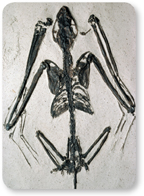Forces from space have even altered Earth's physical environment. There is strong evidence that comets and large meteors have crashed into Earth many times in the past. Some of these impacts may have been so violent that they kicked enough dust and debris in the atmosphere to cause, or contribute to, worldwide extinctions of organisms on land and in the water.
Biological Forces Although we think of life as reacting to Earth's physical environment, in many cases life actually plays a major role in shaping that environment. Iron deposits in ancient sedimentary rock indicate that Earth's early oceans contained large amounts of soluble iron and little oxygen. The first photosynthetic organisms began absorbing carbon dioxide and releasing large amounts of oxygen. Our planet has never been the same since then. Earth cooled as carbon dioxide levels dropped. The iron content of the oceans fell, as iron ions reacted with oxygen to form insoluble compounds that settled to the ocean floor. These changes affected climate and ocean chemistry in many ways.  The actions of living organisms over time have changed conditions in the land, water, and atmosphere of planet Earth.
The actions of living organisms over time have changed conditions in the land, water, and atmosphere of planet Earth.
Even today, organisms shape the landscape as they build soil from rock and sand. Plants, animals, and microorganisms are active players in global cycles of key elements, including carbon, nitrogen, and oxygen. Earth is a living planet, and its physical environment reflects that fact.
19.1 Assessment

-
Explain What can a paleontologist learn from fossils?
Relate Cause and Effect Why have so few organisms become fossilized?
-
Review What are the two ways in which geologists determine the age of fossils?
Draw Conclusions Many more fossils have been found since Darwin's day, giving us a more complete record of life's history. How would this information make relative dating more accurate?
-
Explain How are eras and periods related?
Interpret Visuals Use Figure 19–5 to determine when the Silurian Period began and how long it lasted.
-
Review Describe three processes that have affected the history of life on Earth.
Relate Cause and Effect Describe two ways in which continental drift has affected organisms.
VISUAL THINKING
Look at the fossil bat in the photograph below. Describe the fossil. What can you infer about how the organism moved? Explain your answer.


Table of Contents
- Formulas and Equations
- Applying Formulas and Equations
- Mean, Median, and Mode
- Estimation
- Using Measurements in Calculations
- Effects of Measurement Errors
- Accuracy
- Precision
- Comparing Accuracy and Precision
- Significant Figures
- Calculating With Significant Figures
- Scientific Notation
- Calculating With Scientific Notation
- Dimensional Analysis
- Applying Dimensional Analysis




